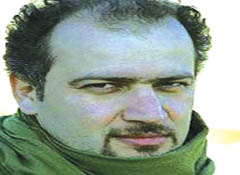
Unlike many of his peers, Oskouei has decided to stay in Iran and keep trying to produce films in and about Iran.
A recipient of the Dutch Foreign Ministry’s 2010 Prince Claus Award of 25,000 euros ($37,000), Oskouei has filmed a variety of typically taboo topics such as female suicide and youth drug addiction.
His 2006 film, “Nose, Iranian Style,” documenting rhinoplasty in Iran, is perhaps his best-known work outside the country. Oskouei says his primary goal was to show the consumerism and nihilism now present in Iran, which has the highest proportion of nose jobs in the world, as opposed to the immediate years after the 1979 revolution when people were committed to sacrificing their lives for their ideals.
Other films by Oskouei could be considered even more delicate. His 2004 “The Other Side of Burqa” films the death and burial of a young bride in a traditional community, where many females commit suicide to escape feelings of being trapped. His most recent film, “The Last Days of Winter,” includes confessions of boys as young as 10, who are active in the criminal and drug worlds because of poverty.
What is impressive is his ability to avoid censorship of his films in Iran.
“In the Western world, it is enough just to be an artist, but not here,” said Ali Dehbashi, editor of the cultural magazine, Bukhara. “Knowing the censors, knowing how things are monitored, is the most important thing.”
“Art is not having one film banned and running to Los Angeles or Paris. The point is to stay, to work and to continue,” said Dehbashi.
Oskouei remarks about his ability to produce approved films very carefully by saying, “We live in a very particular social and political situation.”
In an interview with The New York Times, he asked, “Should I make a film that means I get thrown out of this society? I don’t want that. Should I make a film and use it to seek asylum in another country? I don’t want that at all. In the end, people have to be flexible. I think about how far I can go.”
Oskouei encourages his students to be mindful of governmental limits and opportunities as well. “This has nothing to do with politics or beliefs,” he told five of Iran’s new generation of independent documentarians who wanted to refuse government funding for films about notable figures of the 1979 revolution and Iran-Iraq War. “There are funds for these films, and if we don’t make them, someone else will come along and make heroes out of them.”
Unlike other Iranian directors who work overseas, Oskouei does not want to start making his films outside Iran. For him, it would be a “slow death” far from the “little rascals and desperate women” that people his films, says his friend, Nasser Fakouhi.
Oskouei has always sought to be close to his subjects, going so far as to ride random buses headed anywhere in Iran while a student of cinema at the University of Tehran.
“When they asked me where I wanted to go, I told them it made no difference, and they thought I was making fun of them,” he remembers of the ticket counter employees at bus stations. Of his travels all over Iran, he says, “That’s how I came to know my people—their dreams, their despair, their hopes, their everyday lives.”
Oskouei’s interest in filmmaking began after his father, who had been imprisoned and tortured for anti-Shah activities in the last years before the revolution, asked his son if he wanted to get involved in politics. Oskouei replied, “’No, not at all.’ So I began to think of what I was capable of doing.
“Did I want to be president or prime minister or an MP? I didn’t want that. Or did I want to delve into the spirit of my people and their everyday lives and understand what made them who they are and express this in art? This was what I wanted to do,” Oskouei said.
